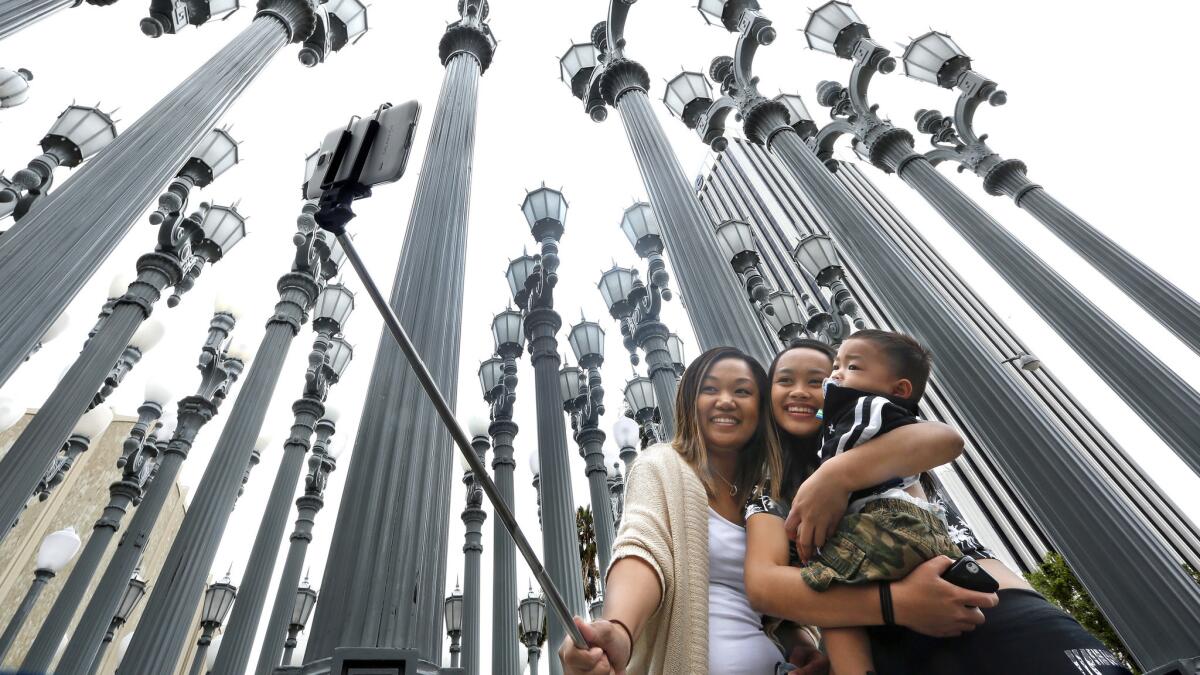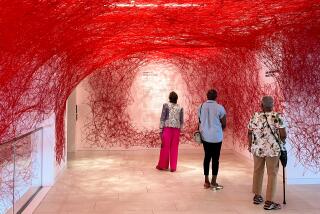Museums embrace ‘iconic selfie moments’ to drive younger visitors

Marjorie Mabini, left, takes a selfie with her niece Jaydah Mabini, and son Jaren, 1, in front of the “Urban Light” installation at the
In one photo, a tourist in a baseball cap stands heroically, face scrunched with effort, raising a 340-ton boulder above his head. In another, a spindly yogi, flat on her back and legs in the air, balances the rock on her feet.
“The Boulder Holder” pose, a selfie that museum-goers take with artist Michael Heizer’s “Levitated Mass” sculpture at the Los Angeles County Museum of Art, is so popular that by one estimate, Instagram photos of the artwork using the #lacma hashtag potentially reach 175,000 people a week.
The museum selfie is having a moment. Institutions around the globe — even some that once frowned on photography or that have banned the selfie stick — are creating even more selfie opportunities, sans stick, as a way to attract visitors, especially millennials.
Some museums are even designing architecture that encourages the phenomenon.
At the San Francisco Museum of Modern Art, an expansion set to open next year includes terraces with views partly designed to encourage selfies. The museum’s curators are also discussing ways to incorporate selfie-friendly moments into exhibitions.
“It’d be foolish for museums not to actively consider this. It plays such an essential role in terms of word of mouth,” said the museum’s chief content officer Chad Coerver. “We are definitely looking at what those iconic selfie moments are going to be at the new SF MOMA.”
During its recent Jeff Koons retrospective, the Centre Pompidou in Paris placed stickers on the floor guiding visitors to the best selfie spots with the artist’s shiny “Hanging Heart.”
The Broad museum, which will open in downtown Los Angeles in September, didn’t consider selfies when configuring its architecture, founding director Joanne Heyler said. Nonetheless, a selfie meme associated with the Grand Avenue building is already emerging.
“The best selfie spots seem to come about organically,” Heyler said. “We’ve recently seen pictures of people taking selfies outside the building and mimicking the ‘oculus’ — a place where the veil of our building indents into the museum.”
The pose: Making a fake dimple by pressing a finger into your cheek.
With their visual focus, art museums are natural places for the trend to flourish. Just ask Beyoncé and Jay Z, who in October famously posted selfies with “The Mona Lisa” at the Louvre in Paris.
The Philadelphia Museum of Art’s selfie spots are its “Rocky” statue and the inspiring run up its stone steps, fists overhead. The National Gallery in Oslo has Edvard Munch’s “The Scream,” glutting the Internet with agonized selfies.
There’s even an interactive art museum in the Philippines, Art in Island, that opened in December dedicated to taking selfies with artworks.
“The upside is that people share their experiences, word spreads, more people come, young people can relate,” said Ann Philbin, director of the Hammer Museum in West Los Angeles. The downside: They don’t often have intimate or contemplative experiences with the art, she said. “That’s what we’re giving up.”
Though the selfie speaks to a culture that values uniqueness and self-expression, it could also be a reaction to the digital world, where experiences are virtual rather than tangible. The selfie screams: “I was actually here!”
“Social media put a huge premium on the instant sharing of experience,” said Kate Flint, a USC art history professor. “And not just with immediate family and friends, but with a whole network of people who, it’s implicitly assumed, will be somewhere between envious and admiring that you’ve actually made it into the Louvre or the Uffizi.”
Among major museums, LACMA was among the first to embrace the selfie trend. Its “Urban Light” installation by Chris Burden went up in the pre-Instagram year of 2008, and almost immediately began attracting cellphone-wielding self portraitists.
The sculpture is now the museum’s crowd favorite for selfies, spawning nearly 10 times the photos on Instagram compared with Heizer’s rock star.
In its most interactive social media campaign to date, LACMA’s portrait exhibition “Faces of America” asks visitors to take selfies with artworks, then projects selected images back to visitors on monitors.
Every day LACMA looks for selfies to re-post, said Scott Tennent, who oversees the museum’s social media. “It helps lower the intimidation factor that so many museums have to wrestle with, and it inspires creativity.”
Like many museums, the Hammer once barred picture-taking inside its galleries. Then in February last year it reversed the policy to allow flash-free photography.
“We saw it as a necessity and also as an opportunity,” Philbin said. “In the last five years, museums have loosened up around this issue. People want to photograph things to remember them. Cameras are an extension of our bodies at this point.”
The Hammer’s spinning chairs in its main courtyard — which invite visitors to take a whirl — have become the unexpected selfie standout. Since they were installed in February as part of “Provocations: The Architecture and Design of Heatherwick Studio,” hundreds of visitors a week have unleashed their inner child, twirling on the chairs and documenting it in pictures.
“Once we noticed it, we created a hashtag, #spunday,” Philbin said. “Now every Sunday we post our favorite pictures in one of the Spun chairs.”
At the Getty Museum in Brentwood, curators last month rearranged the ornamental mirrors in the South Pavilion decorative arts galleries to make mirror selfies easier to achieve. In January, the Getty launched #MusePose, asking visitors to imitate specific artworks each month and share their selfies on Instagram. Last week alone, #MusePose appeared 618,000 times in users’ Instagram streams.
“It’s about observing what visitors are already enjoying, noticing what they’re noticing, and facilitating that — showing them it’s not this stuffy quiet place you can’t have fun in,” digital engagement manager Annelisa Stephan said.
Not everyone, however — like the Norton Simon Museum in Pasadena — is chasing the selfie op.
“We see other museums do that, but that’s not the Norton Simon style,” said Leslie Denk, director of public affairs. “It’s a serene contemplative experience here, especially in our sculpture garden. We certainly enjoy that visitors take the time to capture and share their experiences, but we don’t coordinate any efforts to encourage that.”
At a Brooklyn exhibition last year, a sculpture by artist Kara Walker depicting an African American “mammy” as a Egyptian sphinx led to graphic selfies of visitors seemingly touching various nude body parts.
“It was really disturbing and stupid and distracted from the meaning of the piece,” said Art in America corresponding editor Michael Duncan. “Museums don’t need to be Disneyland. They need to be places where you experience art, and selfies get in the way.”
Duncan’s view was at odds with British blogger Mar Dixon, who last year launched @MuseumSelfieDay.
“It just went crazy, the hashtag started trending worldwide,” Dixon said, adding that museums in Australia, New Zealand, Russia, Germany and beyond picked up on her campaign. “Some even made selfie stations with signs saying, ‘This is a good place to take a selfie.’”
The art website Hyperallergic, however, wrote that the second Museum Selfie Day on Jan. 20 this year “will forever be remembered as a plague on our social media feeds.” The site called Dixon “the official ringleader of this vast criminal enterprise.”
But that “criminal enterprise” at least got people into museums, SF MOMA’s Coerver said.
“We fundamentally believe that everything we do digitally is still designed to get a human being in front of a physical artwork,” Coerver said. “If selfies encourage that to happen, that’s a good thing for museums. It reinforces this idea that you have to be there.”
Send us your own museum selfies by putting them in the comments or by tweeting them @latimes with the hashtag #MuseumSelfies
More to Read
The biggest entertainment stories
Get our big stories about Hollywood, film, television, music, arts, culture and more right in your inbox as soon as they publish.
You may occasionally receive promotional content from the Los Angeles Times.











